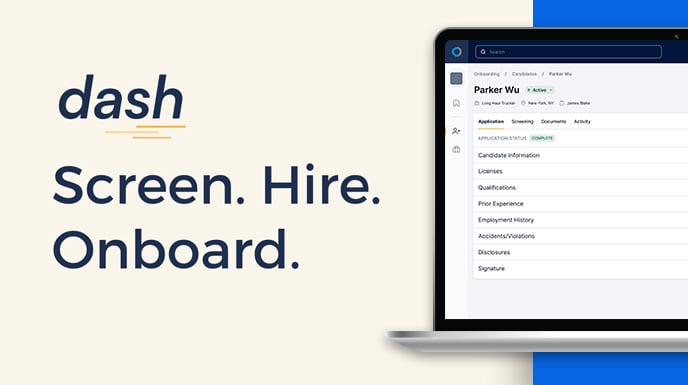How the Drive Safe Act Aims to Curb the Driver Shortage

The newly passed Drive Safe Act takes aim at the trucking industry’s most urgent problem: the driver shortage.
The driver shortage has been an ongoing issue for the trucking industry for some time, but the situation has worsened over the past two years as the pandemic and temporary closure of state DMVs and truck driver training schools have decimated the pipeline of new drivers coming into the workforce. The numbers speak for themselves: the shortage of drivers is now estimated at 80,000, up from 61,000 only three years ago, according to the American Trucking Associations (ATA). And a study last October by ATA chief economist Bob Costello found that the trucking industry is going to have to recruit more than 1 million new drivers—about 110,000 each year—over the next nine years to replace older retiring drivers.
The good news for motor carriers hobbled by driver shortages may lie in a new piece of legislation passed in November as part of President Biden’s $1.2 trillion infrastructure plan. Officially named the Developing Responsible Individuals for A Vibrant Economy Act, the DRIVE-Safe Act (or Drive Safe Act), as it is usually referred to, expands job opportunities by creating a pathway for drivers under the age of 21 to work in interstate trucking. It also initiates improved safety training and technology safeguards for newer drivers who lack the experience of more seasoned veterans.
Under the Drive Safe Act, drivers under 21 who already hold a commercial drivers’ license (CDL) can participate in a two-step apprenticeship program that, if successfully completed, allows them to drive across state lines. While 49 states and the District of Columbia now permit individuals to obtain a CDL at 18, federal law prohibits those operators from transporting their goods from state to state until they’re 21. The new bill requires a driver to complete at least 400 hours of on-duty time and 240 hours of driving time with an experienced driver in the cab with them. It also mandates that all trucks used for training in the program be equipped with advanced safety technology including active braking collision mitigation systems, video event capture, and a speed limiter set at 65 miles per hour or less to automatically regulate speed.
A 120-hour probationary period in which the driver proves competency in more basic driving maneuvers and a 280-our probationary period where he or she must prove competency in more advanced maneuvers are also required. A truck driver who successfully meets these performance standards can engage in interstate driving.
At a time when the country is reeling from the economic devastation wrought by the pandemic, the Drive Safe Act is being hailed by supporters as a victory for the trucking industry. With more than 68 percent of freight moved on U.S. highways, it could potentially open up tens of thousands of new jobs and counter the driver shortage. Ultimately, they assert, it will also help ease the current supply chain crunch.
The bill was introduced for the first time in 2019, then referred to committee, where it languished with no further action taken. Then in March 2020, the Drive Safe Act was rebooted by House Reps. Duncan Hunter (R-Calif.) and Trey Hollingsworth (R-Ind.) The second time was a charm; the Drive Safe Act found bipartisan support from U.S. Senators Todd Young (R-Ind.), Jon Tester (D-Mont.), Tom Cotton (R-Ark.), Jim Inhofe (R-Okla.), Angus King (I-Maine), Joe Manchin (D-W.V.), Jerry Moran (R-Kan.), and Kyrsten Sinema (D-Ariz.), all of whom signed on as cosponsors.
The legislators were backed by a coalition of nearly 90 companies and trade associations, representing sectors as diverse as manufacturing, agriculture and retail. In a letter to Congress, they enumerated the impacts of the driver shortage on aspects of their businesses, from operations to consumer prices.
But opposition to the Drive Safe Act was also considerable: the Owner Operator Independent Drivers Association (OOIDA) and a group of highway safety and law enforcement agencies, consumer groups, and labor unions, in addition to truck crash victims and survivors, mounted an effort against passage of the bill. Their argument? That young drivers are too immature and inexperienced to manage the myriad challenges of handling a massive vehicle under all conditions. OOIDA also contended that corporations would use the law to take advantage of cheap, inexperienced labor, and potentially leave young drivers open to predatory practices and more crashes. Nonetheless, the Drive Safe Act was signed into law in November 2021.
While the Drive Safe Act doesn’t address all the recruiting and retention issues inherent in long-haul trucking, motor carriers are likely to benefit from the robust pool of younger eligible drivers that will be available in coming years. Moreover, new technologies and safety and monitoring programs are likely going to assuage some of their liability concerns. The latest safety systems, for example, employ in-cab cameras to watch for distracted behavior such as eating or cell phone use. They are often used along with outward-facing cameras that trigger an alarm if the truck is approaching another vehicle or pedestrian on the road too fast.
Also beneficial is an MVR Monitoring Program, which monitors drivers’ Motor Vehicle Reports on an ongoing basis to help businesses more easily identify problems, address concerns, and put corrective action plans in place (if needed) when patterns of unsafe driving emerge. By constantly monitoring driving records and looking for new information, the Foley program can red-flag any change and immediately evaluate it for accuracy. Employers are immediately alerted to a “hit” and receive the updated MVR for review.
Ready to learn more? Click here to see how Foley’s MVR Monitoring program can help you better track driver’s behavior – while also preventing 33 percent of common FMCSA violations.
Related Articles
Worsening Driver Shortage is Carriers’ Top Issue of 2021
Retaining Drivers is More Important Than Ever—Here’s What They Care About
Driver Shortage Tops Industry Issues for 2018
.png)



![[NEW WEBINAR] Our Solution to the Driver Shortage](https://www.foleyservices.com/hubfs/Imported_Blog_Media/d18be10a-272f-4d49-bb34-73625ed56c76-1-1-1.png)
